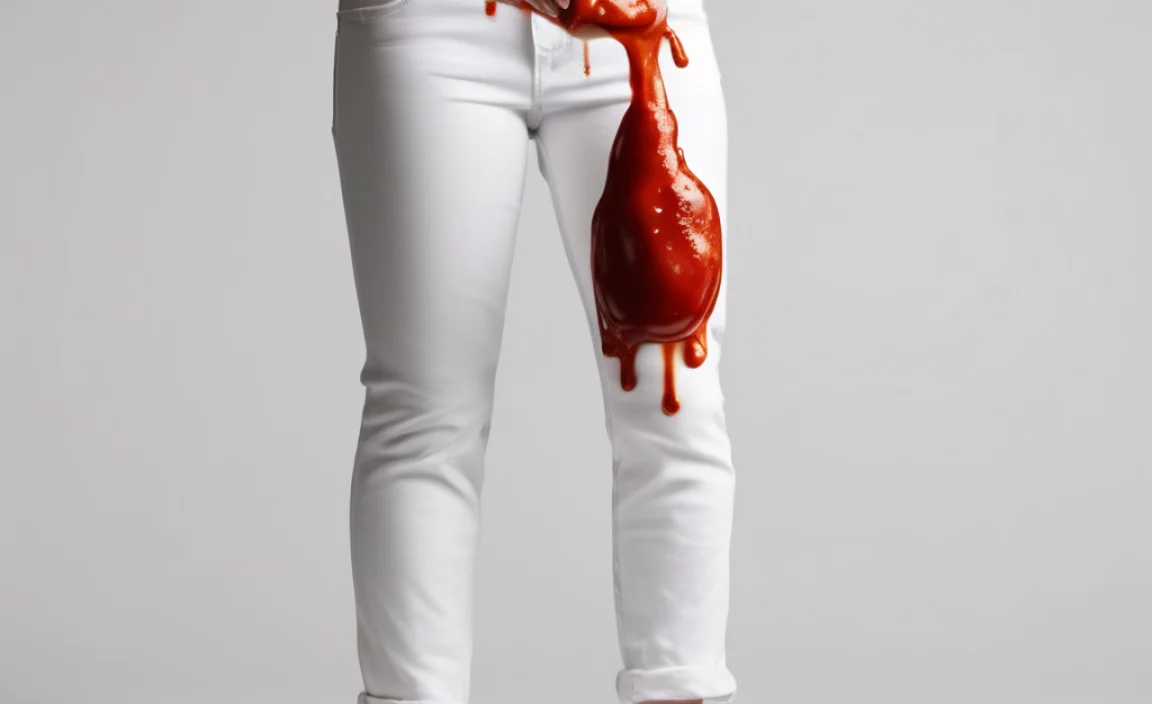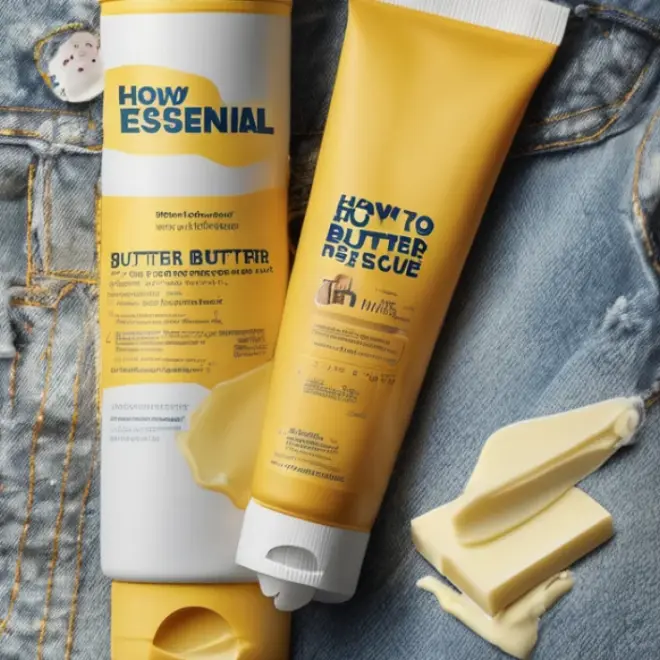Quick Summary: To remove ketchup from white jeans, act fast! Blot gently, then create a paste of baking soda and water. Apply, let it sit, and gently scrub before rinsing. For stubborn stains, a mild detergent or specialized stain remover can be effective. Always test any cleaning solution on an inconspicuous area first.
That dreaded red splotch on your crisp white jeans can feel like a fashion emergency. Ketchup, with its vibrant color and tendency to seep into fabric, is a notorious culprit. But don’t worry, a ketchup stain on white denim is not a lost cause. With the right approach, you can effectively tackle this pesky problem and restore your favorite jeans to their pristine condition. This guide will walk you through simple, proven methods to remove ketchup stains, making it feel less daunting and more achievable.
We’ll start with the quickest fixes for fresh spills and move to more involved techniques for set-in stains. You’ll learn what supplies you likely already have at home and how to use them for maximum effectiveness. By following these steps, you can confidently deal with ketchup mishaps and keep your white jeans looking brilliant.
Understanding Ketchup Stains on White Jeans

Ketchup is a common condiment made from tomatoes, vinegar, sugar, and spices. The primary components that cause staining are the pigments in the tomato and the acidity from the vinegar and tomatoes themselves. On white fabric, these pigments can be particularly noticeable and adhere to the fibers, making quick action crucial.
White clothing offers no pigment of its own to camouflage the stain, making it appear more prominent than on colored garments. The delicate nature of denim also means that aggressive scrubbing can lead to damage or wear. Therefore, a gentle yet effective approach is key to removing ketchup without harming your white jeans.
The Golden Rule: Act Fast!

The single most important factor in successfully removing any stain, especially ketchup from white jeans, is speed. The longer the ketchup sits on the fabric, the deeper it will penetrate the fibers, and the harder it will be to remove. Fresh stains are significantly easier to tackle than dried-on ones.
Think of it like this: a fresh stain is like a fresh painting still wet on the canvas – it can be wiped away with relative ease. A dried stain is like a painting that has cured and bonded with the canvas – it requires more effort and specialized techniques to lift.
Essential Supplies for Ketchup Stain Removal

Before you begin, gather the necessary tools. Most of these are common household items:
- Clean white cloths or paper towels
- Cold water
- Baking soda
- Mild dish soap (like Dawn)
- White vinegar (optional, for stubborn stains)
- Enzyme-based laundry detergent (check labels for stain-fighting enzymes)
- An old toothbrush or soft-bristled brush
- A small bowl
- Ice cubes (optional, for setting fresh stains before treatment)
Having these items ready will ensure you can address the stain immediately, maximizing your chances of a complete removal.
Step-by-Step Guide to Removing Fresh Ketchup Stains

This method is designed for ketchup spills that have just happened or occurred within the last hour or two.
Step 1: Blot, Don’t Rub!
Immediately grab a clean white cloth or paper towel. Gently blot at the stained area. The goal here is to absorb as much of the excess ketchup as possible without spreading it further into the fabric. Avoid any rubbing motion, as this can push the stain deeper and larger.
Imagine you are trying to pick up as much of the physical ketchup from the surface as possible. Use a fresh section of the cloth or a new paper towel as needed.
Step 2: Rinse with Cold Water
Turn the jeans inside out and hold the stained area under a stream of cold running water. Flush the stain from the backside of the fabric. This helps push the ketchup particles out of the fibers. Continue rinsing for a few minutes. Hot water can set protein-based stains, so always start with cold.
Step 3: Create a Baking Soda Paste
In a small bowl, mix baking soda with a small amount of cold water to create a thick paste. The consistency should be similar to toothpaste. Baking soda is a mild abrasive and a natural whitener, making it excellent for lifting stains from white fabrics.
The chemical properties of baking soda can help neutralize odors and break down certain types of stains. You can learn more about the science behind baking soda’s cleaning power on sites like the Environmental Protection Agency (EPA), which often highlights eco-friendly cleaning solutions.
Step 4: Apply the Paste and Let It Sit
Gently spread the baking soda paste over the entire ketchup-stained area. Ensure it covers the stain completely. Let the paste sit for at least 15–30 minutes, or even longer for very fresh and saturated stains.
This allows the baking soda time to work its magic, drawing out the pigment and beginning to lift the stain from the denim fibers.
Step 5: Gently Scrub
Use an old, soft-bristled toothbrush or the edge of your clean cloth to gently work the baking soda paste into the stain. Scrub in small, circular motions, applying only light pressure. The aim is to loosen the stain without damaging the denim.
Step 6: Rinse Again
Rinse the area thoroughly with cold water, ensuring all the baking soda paste is washed away. Check the stain. If it has significantly faded or is completely gone, proceed to washing the jeans.
Step 7: Launder as Usual (with a Check First)
Before drying, inspect the stained area carefully. If the stain is gone, you can wash the jeans according to their care label. It’s often best to wash white jeans with other whites to prevent color transfer.
Crucially, do not put the jeans in the dryer if any trace of the stain remains. The heat from the dryer will set the stain permanently, making it nearly impossible to remove later.
Treating Set-In or Stubborn Ketchup Stains

If the ketchup stain has dried, or if the fresh stain method didn’t entirely work, you’ll need to employ slightly different techniques. Don’t despair; even dried stains can often be rescued.
Method 1: Mild Detergent and Cold Water Soak
For dried stains, start by gently loosening any crusty ketchup residue with a dull knife or the edge of a credit card. Then, proceed with the cold water rinsing and baking soda paste as described above. If the stain persists after the baking soda treatment:
- Fill a basin or sink with cold water.
- Add a tablespoon of mild liquid dish soap (one known for its grease-cutting power) or an enzyme-based laundry detergent.
- Submerge the stained portion of the jeans in the water and let it soak for at least 30 minutes, or up to a few hours for very stubborn stains.
- Gently agitate the fabric in the water periodically.
- After soaking, gently rub the affected area with your fingers or the soft brush.
- Rinse thoroughly with cold water.
- Inspect the stain and repeat if necessary, or proceed to wash.
Method 2: White Vinegar Solution (for tougher stains)
White vinegar is a mild acid that can help break down tough stains. However, always test on an inconspicuous area of the jeans first to ensure it doesn’t affect the fabric color or texture. Some denim treatments might react unexpectedly.
- Mix equal parts white vinegar and cold water in a small bowl.
- Apply this solution directly to the stain using a clean cloth or cotton ball.
- Let it sit for about 10–15 minutes.
- Gently blot or scrub with a soft brush.
- Rinse thoroughly with cold water.
- Proceed with washing instructions.
Vinegar works by loosening the bonds between the staining agents and the fabric fibers, making them easier to wash away. For more information on common household cleaning agents, you can refer to resources like the Clean Kitchens Institute, which often details the properties of various cleaning ingredients.
Method 3: Commercial Stain Removers
If home remedies aren’t cutting it, a commercial stain remover specifically designed for clothing can be a lifesaver. Look for products that contain enzymes, as these are highly effective at breaking down protein and organic stains like ketchup.
Follow the product’s instructions carefully. Typically, you’ll apply the remover directly to the stain, let it sit for the recommended time, and then wash the garment. Always choose a remover safe for white fabrics.
Types of Commercial Stain Removers
| Type of Stain Remover | Pros | Cons |
|---|---|---|
| Enzyme-based liquid removers | Highly effective on organic stains like ketchup; good for pre-treating. | May require multiple applications for very tough stains. |
| Oxygen-based bleaches (e.g., OxiClean) | Safe for most whites; powerful at lifting color and brightens fabric. | Can take time to work; requires soaking for best results. |
| Chlorine bleach (use with extreme caution) | Very powerful whitener; effective on very stubborn stains. | Can damage fabric fibers with overuse; must be diluted; not safe for all denim finishes or colors. Use as a last resort and test thoroughly. |
When using any commercial product, it’s always wise to check the stain remover’s compatibility with denim and white fabrics. Some specialized denim washes or treatments might be sensitive to certain chemicals.
What NOT to Do
To ensure you don’t accidentally make the ketchup stain worse, avoid these common mistakes:
- Rubbing: As mentioned, rubbing spreads the stain and can damage the fabric.
- Hot Water: Hot water can cook protein and pigment into the fibers, setting the stain. Always start with cold.
- Drying Before Stain is Gone: Direct heat from a dryer will permanently set the stain. Air dry until you are certain the stain is removed.
- Using Colored Cloths: If you’re blotting or applying solutions, use only white cloths to avoid transferring dye to your white jeans.
- Harsh Scrubbing: Excessive force can fray the denim fibers, creating a worn or damaged appearance.
Caring for White Jeans Long-Term
Prevention and proper care are always easier than stain removal. Here are some tips to keep your white jeans looking their best:
- Wash Separately: Always wash white jeans with other white items to avoid color transfer.
- Use a Gentle Cycle: A shorter, gentler wash cycle is kinder to the fabric.
- Cold Water Wash: Stick to cold or cool water for washing white denim.
- Air Dry When Possible: While dryer heat sets stains, air drying also helps maintain fabric integrity and prevents shrinkage compared to high heat drying. If you must use a dryer, use a low heat setting.
- Inspect Before Wearing: Give your white jeans a quick once-over before wearing them out, especially if you’re eating messier foods.
Frequently Asked Questions (FAQ)
Q1: Will ketchup stain my white jeans permanently?
Not necessarily! If you act quickly and follow the right steps, most ketchup stains can be removed from white jeans. The key is immediate action and using appropriate cleaning agents.
Q2: Can I use bleach on my white jeans?
Chlorine bleach can be used as a last resort for very stubborn stains, but it should be done with extreme caution. Always dilute it significantly and test it on an inconspicuous area first, as bleach can weaken denim fibers and cause yellowing if overused or if the jeans contain certain dyes or finishes.
Q3: How long should I let a stain remover sit?
Follow the instructions on the stain remover’s packaging. For home remedies like baking soda paste or vinegar solutions, 15-30 minutes is usually sufficient, but for set-in stains, longer soaking times might be beneficial.
Q4: What if the stain is old and dried on my white jeans?
For old, dried stains, start by gently scraping off any excess dried ketchup. Then, try soaking the area in cold water with an enzyme-based detergent for several hours or overnight. After soaking, treat with a baking soda paste or a commercial stain remover, and then wash.
Q5: Is it safe to use laundry detergent directly on the stain?
Yes, in many cases. You can apply a small amount of liquid laundry detergent directly to the stain after blotting and rinsing, then gently rub it in before letting it sit for a few minutes and washing. Enzyme-based detergents are often most effective.
Q6: What is an enzyme-based detergent?
Enzyme-based detergents contain specific enzymes that break down different types of stains, such as protein (from food), starch, and fat. They are particularly effective on organic stains like ketchup and are a great choice for tackling laundry mishaps. Many modern laundry detergents are formulated with these powerful cleaning agents.
Conclusion
Dealing with a ketchup stain on your white jeans might seem daunting, but with these proven methods and a little patience, you can successfully restore your favorite denim. Remember, the sooner you address the stain, the easier it will be to remove. Start with gentle blotting and cold water, move to household remedies like baking soda, and don’t hesitate to use a good commercial stain remover if necessary.
By following these practical steps, understanding what works and what to avoid, you can confidently tackle ketchup spills and keep your white jeans looking fresh and bright. Always inspect your jeans thoroughly before drying to ensure the stain is completely gone. Happy stain fighting!











